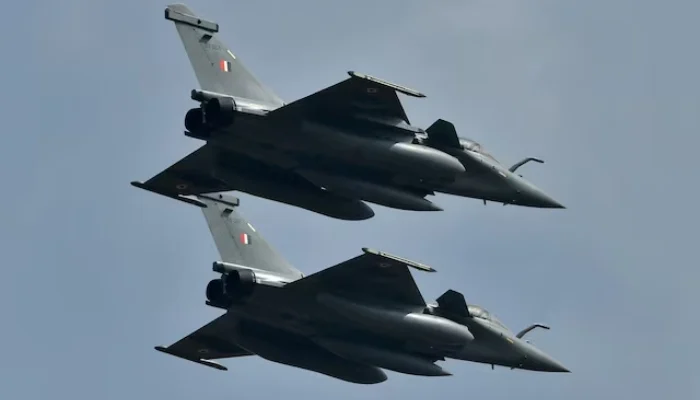A dogfight involving Chinese-made Pakistani jets and French-made Indian Rafale fighters is set to be intensely scrutinised by militaries worldwide, seeking critical insights that could provide an advantage in future conflicts.
A Chinese-made Pakistani fighter plane reportedly shot down at least two Indian military aircraft on Wednesday, according to two US officials who spoke to Reuters, potentially marking a significant milestone for Beijing’s advanced fighter jet technology.
This aerial clash presents a rare opportunity for military strategists to analyse the performance of pilots, fighter jets, and air-to-air missiles in live combat scenarios, with the aim of leveraging this knowledge to refine their own air force tactics and preparedness.
Experts suggest that the real-world deployment of advanced weaponry will be closely examined globally, including in China and the United States, both of which are preparing for potential confrontations over Taiwan or in the broader Indo-Pacific region.
One US official, who requested anonymity, informed Reuters that there was strong confidence that Pakistan had employed the Chinese-made J-10 aircraft to launch air-to-air missiles against Indian fighter jets.
Social media discussions have heavily focused on the performance of China’s PL-15 air-to-air missile against the Meteor, a radar-guided air-to-air missile manufactured by the European group MBDA. However, official confirmation of these specific weapons being used is still pending.
“Air warfare communities in China, the US and a number of European countries will be extremely interested to try and get as much ground truth as they can on tactics, techniques, procedures, what kit was used, what worked and what didn’t,” stated Douglas Barrie, a senior fellow for military aerospace at the International Institute for Strategic Studies.
Barrie added, “You have arguably China’s most capable weapon against the West’s most capable weapon, if indeed it was being carried; we don’t know that.”
He further noted that the French and Americans would likely be hoping to gather similar intelligence from India.
“The PL-15 is a big problem. It is something that the US military pays a lot of attention to,” commented a defence industry executive.
Rafale manufacturer Dassault Aviation declined to comment, and MBDA could not be immediately reached for comment due to a French public holiday.
Limited Details Available
Western analysts and industry sources indicate that crucial details remain unclear, including whether the Meteor missile was actually carried by the Indian aircraft and the level and type of training the pilots involved had received. Analysts also pointed out that arms firms would be eager to differentiate between the technical capabilities of the weapons and the operational factors at play.
“There will be audits of what works and what doesn’t work, but I think the other overlay is the proverbial fog of war,” said Byron Callan, a Washington-based defence expert and managing partner at Capital Alpha Partners.
He noted that US arms companies are continuously receiving feedback on the performance of their products in the ongoing war in Ukraine.
“So I absolutely expect the same to be the case with India’s European suppliers, and Pakistan and China are probably sharing the same feedback. If the PL-15 is working as advertised or better than expected, the Chinese would like to hear that.”
A defence industry source from a Western country operating the Meteor missile mentioned that an online image of a seeker appeared to show a component of a missile that had missed its target. Conflicting reports exist regarding whether Pakistan possesses the domestic version of the PL-15 used by the PLAAF (China’s air force) or the lower-range export version publicly unveiled in 2021.
Barrie, who has extensively written about the missile, stated his belief that Pakistan most likely possesses the export variant.
A Western industry source downplayed claims that the rocket-powered PL-15 had a longer range than the air-breathing Meteor but acknowledged that its capability “may be greater than was thought.” The Meteor’s range has not been officially disclosed. “At the moment, it’s not possible to judge anything. We know so little,” the industry source commented.
The PL-15’s range and overall performance have been a subject of significant interest in the West for years. Its emergence was seen as a key indicator that China had significantly advanced beyond its reliance on Soviet-era derivative technology in aerospace.
The United States is currently developing the AIM-260 Joint Advanced Tactical Missile through Lockheed Martin, partly as a direct response to the PL-15 and its beyond-visual-range capabilities, representing a broader shift in Western defence priorities towards China.
European nations are exploring a mid-life upgrade for the Meteor missile, which specialist publication Janes suggests could involve improvements to its propulsion and guidance systems, although analysts indicate that progress in this area has been slow.
US President Donald Trump awarded Boeing a contract in March to develop the US Air Force’s most sophisticated fighter jet to date, which is expected to incorporate stealth technology, advanced sensors, and cutting-edge engines.



